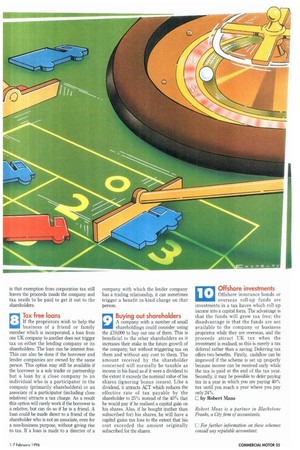Spend! Spend.
Page 36

Page 37

If you've noticed an error in this article please click here to report it so we can fix it.
Spend!
What can best be done with a cash windfall? Let's assume you've sold a couple of trucks for £10,000 and it's not needed in the business for the foreseeable future. Here are 10 ways of making that £10,000 work for its living, rather than leave it languishing in the bank..
LI Shareholders' payout
The first possibility is to pay it to
LI Shareholders' payout
The first possibility is to pay it to your shareholders—which for many hauliers means the family—or to draw the funds out and invest the money personally. This is no problem for the unincorporated business, but tax usually has to be paid to extract the funds from a limited company. How much depends on whether the money comes out as dividend or extra salary, and on the company's tax position and that of its shareholder directors.
Let us assume the following: That the payment is made after 6 April 1996; that the company has sufficient taxable income to absorb the advance corporation tax (ACT) on a dividend and can cope with the cashflow effect of paying the tax early; that if extra salary is taken the director's basic salary already exceeds the £23,660 employee's national insurance threshold; and that the £10,000 salary will be grossed up for the tax relief it will generate. In these circumstances, the net receipt by a 40% taxpayer will be 17,500 via a dividend or £7,175 via a bonus if the company pays corporation tax at 24%; or £7,500 and £8,141 respectively if it is taxed at 33%. For a 24% taxpayer, the corresponding figures are 110,000 and 19,088 (or 110,312 if the company is taxed at 33%).
Pension fund
The money could prosper in a pension fund if the maximum permitted provision under an approved pension scheme has not been made. The payment will attract a corporation tax or income tax deduction. It will not attract an immediate tax liability, but it is locked away until the director or proprietor reaches retirement age. Both income and capital gains generated by the fund are free of tax so the money will grow more rapidly than if it is invested by either the shareholder or the company.
Buying an asset
The company can buy an asset—
such as a computer or an antique desk, both of which are paid for personally but used in the business—from a shareholder. This gives the shareholder the use of the funds while retaining effective control over the asset without triggering tax except to the extent that there is a capital gain on the sale. This will not normally work if the asset takes the form of shares or securities of another company, including stock exchange securities. It is also unattractive if the asset is anything that is in the shareholder's home which can be used privately as ownership by the company will attract a benefit-in-kind tax.
4 Directors' benefits
Another option is to use the money to Another option is to use the money to provide benefits for the director shareholders. This is not always tax efficient, however. For example, a larger car for a director will attract a higher company car tax, but that may well be small compared with the director running the car himself.
ElEnterprise zpneis investment hinds The next possibilities are tax shelter investments. While 110,000 will not go very
far it will buy an interest in either of two property/land investments: an Enterprise Zone Investment Fund or a Woodlands fund. The benefit of an enterprise zone investment is that investments in a fund which builds in a designated zone receive tax relief of 100%. However, this tax relief is clawed back if the fund sells its building 11111111Min within 25 years or grants a long lease of it within seven.
A bigger problem is that many enterprise zone buildings have been disasters in
investment terms so they tend to be high risk investments. Rental income and capital gains are taxable in the normal way 6 Woodlands funds
Woodlands in contrast do not attract Woodlands in contrast do not attract up-front tax relief. Instead all income and capital gains are exempt from tax with the exception of a capital gain on the land element of the woodland, as opposed to the value of the growing timber itself.
Ei Works of art Ei Works of art
Small works of art, antiques, and collectors' items can be bought to take advantage of the chattels exemption. This exempts capital gains on such items from tax provided the sale proceeds of each individual item is less than £6,000. Items that form a set or collection must be treated as a single item. If the proceeds exceed 16,000 there is marginal relief but this normally phases out fairly quickly. A possible snag with both this and Woodlands is that exemption from corporation tax still leaves the proceeds inside the company and tax needs to be paid to get it out to the shareholders.
Tax free loans
If the proprietors wish to help the business of a friend or family member which is incorporated, a loan from one UK company to another does not trigger tax on either the lending company or its shareholders. The loan can be interest free. This can also be done if the borrower and lender companies are owned by the same person. This option may still be available if the borrower is a sole trader or partnership but a loan by a close company to an individual who is a participator in the company (primarily shareholders) or an associate of a participator (including close relatives) attracts a tax charge. As a result this option will rarely work if the borrower is a relative, but can do so if he is a friend. A loan could be made direct to a friend of the shareholder who is not an associate, even for a non-business purpose, without giving rise to tax. If a loan is made to a director of a company with which the lender company has a trading relationship, it can sometimes trigger a benefit in kind charge on that person.
Buying out shareholders
A company with a number of small shareholdings could consider using the £10000 to buy out one of them. This is beneficial to the other shareholders as it increases their stake in the future growth of the company, but without triggering tax on them and without any cost to them. The amount received by the shareholder concerned will normally be taxable as income in his hand as if it were a dividend to the extent it exceeds the nominal value of his shares (ignoring bonus issues). Like a dividend, it attracts ACT which reduces the effective rate of tax payable by the shareholder to 25% instead of the 40% that he would pay if he realised a capital gain on his shares. Also, if he bought (rather than subscribed for) his shares, he will have a capital gains tax loss to the extent that his cost exceeded the amount originally subscribed for the shares 10 Offshore investments
Offshore insurance bonds or
overseas roll-up funds are investments in a tax haven which roll up income into a capital form. The advantage is that the funds will grow tax free; the disadvantage is that the funds are not available to the company or business proprietor while they are overseas, and the proceeds attract UK tax when the investment is realised, so this is merely a tax deferral rather than a saving. Deferring tax offers two benefits. Firstly, cashflow can be improved if the scheme is set up properly because income can be received early while the tax is paid at the end of the tax year. Secondly, it may be possible to defer paying tax in a year in which you are paying 40% tax until you reach a year where you pay only 24%.
E] by Robert Maas
Robert Maas is a partner in Blackstone Franks, a City firm of accountants.
0 For further information on these schemes consult any reputable accountant.
































































































